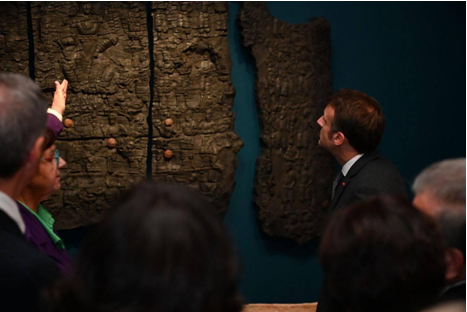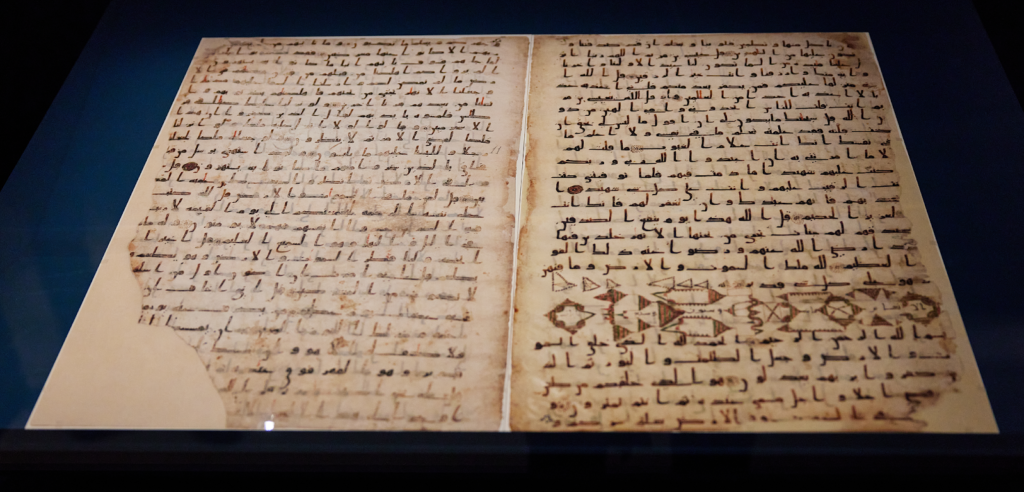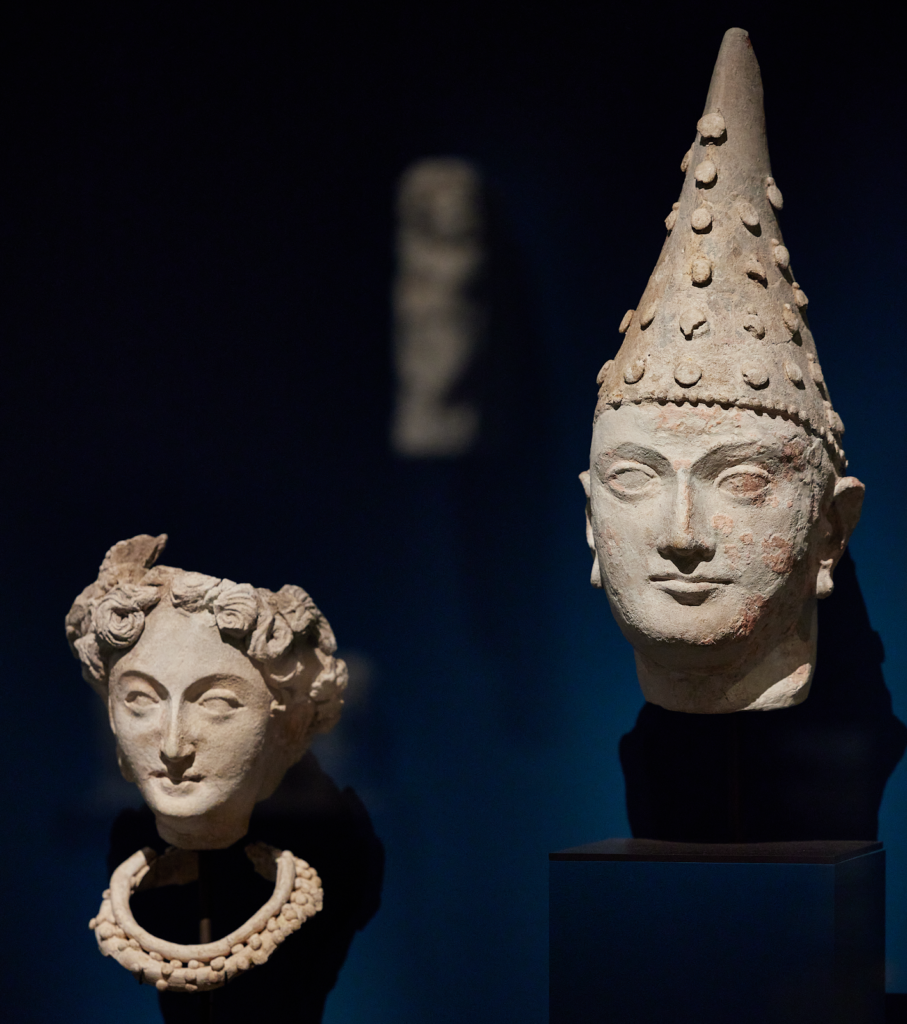Spokesman Report
During the official visit of the President of Uzbekistan Shavkat Mirziyoyev to France, at the invitation of the President of France Emmanuel Macron, the heads of the two states opened two major exhibitions: “The Splendours of Uzbekistan’s Oases. At the Crossroads of Caravan Routes” in the Louvre and “The Road to Samarkand. Miracles of Silk and Gold” at the Arab World Institute.
Both exhibitions are dedicated to Uzbekistan’s history and culture. The exhibition in the Louvre covers the 5th-6th centuries BC to the reign of the Timurids, and the Arab World Institute presents exhibits of the 19th – mid-20th centuries, as well as paintings of the Turkestan avant-garde from the collection of Uzbekistan state museums.
How it all began

In October 2018, President of Uzbekistan Shavkat Mirziyoyev paid an official visit to France for the first time. As part of the cultural program, an excursion to the Louvre took place. By that time, the idea of holding a large-scale exhibition in this museum dedicated to the rich historical and cultural heritage of Uzbekistan was already taking shape, and the Head of the state warmly supported it.
It should be noted that this was preceded by several very important events.
In 2009, archaeologist and researcher Rocco Rante led an archaeological mission in Bukhara in collaboration with the team of Samarkand Archeology Institute of the Academy of Sciences of the Republic of Uzbekistan. From the Uzbek side, it was headed by Jamal Mirzaakhmedov, and later by Abdisabur Raimkulov. In 2011, Rante invited Henri Loyrette, the former Director of the Louvre, to Uzbekistan. After assessing the available historical material, a decision is made to start planning a possible exhibition, which took on a concrete shape in 2017.

Sometime later, already in Samarkand region of Uzbekistan, a unique Zoroastrian carved panel was discovered during other excavations, which were also carried out jointly with French specialists. The find claimed to be a world-class discovery.
It is assumed that the country palace of the rulers of pre-Islamic times (until the 8th century) was located at the excavation site. A front room was discovered in the citadel, most of which was occupied by a three-tiered podium, where, according to scientists, the ruler sat on the throne, and the panel just adorned the walls of the hall.
Along with these, other unique finds were discovered. It became clear that Uzbekistan would be able to show the world something very valuable from a historical and cultural point of view.
The Art and Culture Development Foundation of Uzbekistan, represented by Executive Director Gayane Umerova, and the Louvre Museum signed a Partnership Agreement, and preparatory work began, which was led by the Deputy Chairperson of the Council of the Foundation Saida Mirziyoyeva.
The exhibition at the Louvre was planned to be held in 2020-2021, but COVID-19 disrupted these plans, and it had to be postponed to 2022. During this period, it became clear that it would be logical to present an excursion not only into the ancient history of Uzbekistan, ending with the 15th century, but also to tell about the following periods up to modern times, which would make this work comprehensive and complete. Based on this, it was decided to hold two exhibitions: one at the Louvre, and the second at the Arab World Institute.
Four-year journey
A special commission was created to prepare both exhibitions. It was led by the Prime Minister of the Republic of Uzbekistan, which included the Director of the Institute of Art History of the Academy of Sciences of the Republic of Uzbekistan and project consultant Shokir Pidayev, Director of the Center for Islamic Civilization Shoazim Minovarov, ministers, scientists, archaeologists, as well as directors and curators of museums from which it was planned to borrow exhibits.
Major restoration work began. More than 70 items have been restored especially for the exhibition since 2018. A team was involved in the project, including more than 40 restorers in paper, wood, metal, sculpture, glass and wall painting from France and Uzbekistan, including Marina Reutova, Kamoliddin Mahkamov, Shukhrat Pulatov, Christine Parisel, Olivier Tavoso, Delphine Lefebvre, Geraldine Frey, Axel Delau, Anne Liege, and others.
Particularly difficult and interesting was the restoration and conservation of the Kattalangar Quran pages of the 8th century. This Quran has tremendous religious significance for Islam and Muslims and is one of the values that constitute the cultural and historical heritage of all mankind.
The restoration work lasted three years and was made possible largely thanks to the personal support of Saida Mirziyoyeva, who then held the position of Deputy Director of the Agency for Information and Mass Communications. Initially, it was planned to restore only 2 pages, and it was Saida Mirziyoyeva who insisted on restoring all 13 pages.
The National Library of Uzbekistan named after Alisher Navoi, the Art and Culture Development Foundation under the Ministry of Culture of the Republic of Uzbekistan, and the Muslim Board of Uzbekistan were involved in the restoration of this unique document. The work was carried out by the restorers of the Louvre Museum Axel Delau and Aurelia Streri.
“The Splendours of Uzbekistan’s Oases. At the Crossroads of Caravan Routes”
The exhibition “The Splendours of Uzbekistan’s Oases. At the Crossroads of Caravan Routes” covers the period from the 5th-6th centuries BC to the era of the Timurids, telling about the history of the Great Silk Road, which passed through the southern part of present-day Uzbekistan. It presents objects of monumental art, wall paintings, carved details of palaces, objects of arts and crafts, and others. The exhibition includes 169 museum exhibits, in particular 138 items from 16 museums of the Republic of Uzbekistan, as well as 31 exhibits from the world’s leading museums. Among them are the Louvre Museum, the National Library of France, the British Museum and the British Library, the Victoria and Albert Museum in London, the Cabinet of Medals in Paris, the Guimet Museum and the Languages and Civilizations University Library (BULAC), the Calouste Gulbenkian Foundation in Lisbon.
The curators of the exhibition are Yannick Lintz and Rocco Rante.
As Saida Mirziyoyeva noted, Uzbekistan has always been a place of cultural exchange and trade, and the Great Silk Road has become, in a sense, the first global economic project. Covering about two thousand years, the exhibition at the Louvre will provide a multifaceted view of the culture of various civilizations that existed on the territory of present-day Uzbekistan, as well as show the country’s unique heritage in the global cultural context, which is one of our main tasks.
In turn, Rocco Rante noted that the exhibition has two main goals. First, it is to show the civilization and culture of Central Asia in Europe. And Paris is the best place for this, because here is one of the leading museums in the world – the Louvre.
The second goal is to show the close historical connection between Central Asia and Europe. After all, these two regions have a lot of common historical moments.
In addition, the exhibition has an educational meaning for European and French societies to get to know Central Asia better. After all, its culture has an important place in human civilization and is rich in significant historical figures.
Rante also noted that the exhibition “The Splendours of Uzbekistan’s Oases. At the Crossroads of Caravan Routes” in the Louvre will become unique over the next 30-40 years.

In addition to the Katta Langar Quran, especially unique exhibits include a charred wooden panel from the settlement of Kafir-Kala, a statue of Buddha “Garland-bearer” (1st century BC – 1st century AD), the head of a Kushan prince from the settlement of Dalverzin-Tepe (1st-2nd centuries), the famous wall painting of the 7th century, depicting a hunting scene, found in the ancient settlement of Varakhsha in Bukhara region, a copy of the book of Marco Polo of the 14th century about his wanderings in Asia.

At the same time, taking into account that many archaeological discoveries, as well as significant restoration work, have been made over the past 3 years, part of the exposition will be shown to the public for the first time.
“The Road to Samarkand. Miracles of Silk and Gold”
The exposition of this exhibition, consisting of more than 300 exhibits from 9 museums of Uzbekistan, includes objects of applied art, which are important elements of Uzbek identity and diversity.
of Uzbekistan, includes objects of applied art, which are important elements of Uzbek identity and diversity.
Visitors can become acquainted with samples of national textiles, costumes, hats, jewelry of the 19th – mid-20th centuries, gold-embroidered chapans of the era of the Bukhara Emirate, carpets and much more, made in various techniques.
The exhibition also presents 23 paintings, including works of the Turkestan avant-garde from the collection of the State Museum of Arts of the Republic of Karakalpakstan named after I. V. Savitsky in Nukus. Between 1917 and 1932, Turkestan was a particularly popular geographical destination among Russian avant-garde artists. At the time when Matisse was discovering Morocco, avant-garde artists in search of “local color” found for themselves a unique source of inspiration in the richness of landscapes, forms and faces of Central Asia.
One of the most interesting exhibits here can be a tobelik, a traditional headdress of a Karakalpak woman in the 17th-18th centuries. Tobelik has a cylindrical shape, assembled from silver plates with coral and turquoise inserts. It is believed that it served as an additional decoration, a kind of crown, which was worn on a saukele – a wedding headdress.
Kimesheks are also presented here. This is also a women’s national headdress. Kimeshek completely covers the head, while the face remains open. It looks like a hood. Married women wore kimesheks of specific colors, thereby emphasizing their status.
Undoubtedly, the attention of visitors will be attracted by arebeks – small nose rings. They were made of gold and decorated with spiral curls, small turquoise and coral beads. Arebeks were worn on the right wing of the nose by young Karakalpak women, and these decorations are not found anywhere else on the territory of Uzbekistan. If you draw parallels, they can be recognized as an analog of modern piercing.
Among the selected paintings are paintings by Ural Tansikbayev, Victor Ufimtsev, Nadejda Kashina. There are paintings by Alexander Volkov, Alexei Isupov and others. Despite the unique style of writing each of them, all the paintings are inspired and united by one theme – the East and its color. So, having seen, for example, the picture of Nikolai Karakhan “Teahouse near the house under the elms”, the viewer can immediately understand how people of that time dressed and how they rested, their way of life, and the surrounding nature.
A very interesting painting by Victor Ufimtsev “Oriental Motif”. A native of Siberia, the artist, as he became acquainted with Central Asia, gradually mastered the traditional art of Islam. This work is a free modernist stylization of a Muslim miniature, which reproduces the classic banquet scene. The painting depicts two women at rest, towards which a man with a vessel is moving. It seems that the Western viewer, looking at this canvas, will be able to appreciate how high the respect for women has always been in the East.
In general, it should be noted that the entire collection as a whole, presented by the Savitsky Museum, is designed to reveal all the diversity, originality and charm of oriental culture and Uzbekistan in particular. And it is very symbolic that it will be presented at the Arab World Institute, located in the famous European capital. This once again proves that the West and the East can perfectly coexist and enrich each other.
One of the curators of the exhibition, the head of the French publishing house Assouline Publishing, Yaffa Assouline, and photographer Laziz Hamani, provided great assistance in creating the exposition. For three years they traveled across the region to search and collect materials for publications about Uzbekistan. The exhibition “The Road to Samarkand. Miracles of Silk and Gold” became a living illustration of these books.
Most of the exhibits presented at the exhibition have never left Uzbekistan. But even those who are well acquainted with, for example, chapans, suzani, and other works presented in the country’s museums, will see them in a new light and perspective – in 3D, and this is an unprecedented experience.
Another valuable part of the exhibition is that all regions of Uzbekistan are presented at once with their differences, schools, techniques for manufacturing products.
As Gayane Umerova explained, partnership with the Arab World Institute allows to more thoroughly explore the cultural context of Uzbekistan, to emphasize the significance and richness of its national heritage. The Culture Foundation attaches great importance to the exhibition, since one of its important missions is to raise awareness about the history and cultural heritage of Uzbekistan on a global scale. It is expected that the exhibition will be of interest to a wide range of people who are fond of art, handicraft and the history of the region. Certainly, this project, successfully created jointly with the Arab World Institute, will serve to further develop mutual understanding and cooperation between people.
At the opening ceremony of the exhibition, the ballet performance “Lazgi – Dance of Soul and Love” by the German choreographer Raimondo Rebeck was presented. The Khorezmian Lazgi dance is more than 3000 years old. It is included on the Representative List of the Intangible Cultural Heritage of Humanity of UNESCO.
On a final note
The territory covered by the Silk Road contains traces and treasures of a huge number of civilizations and ethnic groups representing a wide variety of cultures and ways of life. This is a place of intersection of many trade routes, exchange between East and West, nomadic and sedentary ways of life, synthesis of cultures of various civilizations – Iranian, Hellenistic, Turkic, Chinese, Indian, Arab Muslim, Mongolian, and others.
The exhibitions presented by Uzbekistan in Paris will allow millions of people from all over the world to see the artifacts of this great history with their own eyes.
Experts believe that these exhibitions will be very effective, because cooperation in a culture very quickly acquaints the country and people with the world. 60 million tourists visit France a year. More than 10 million people visit the Louvre. The fact that Uzbekistan will be represented at such a large-scale exhibition will make the country more recognizable, increase interest in it, its culture and its history. This will serve as a great advertisement for the development of tourism. The better people get to know each other through exhibitions, mutual communication, the stronger mutual trust. And trust opens the door to other cooperation areas.



